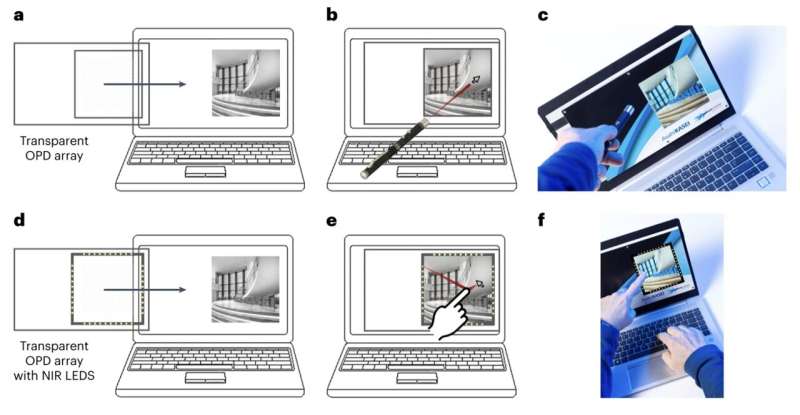July 15, 2023 feature
This article has been reviewed according to Science X's editorial process and policies. Editors have highlighted the following attributes while ensuring the content's credibility:
fact-checked
peer-reviewed publication
trusted source
proofread
Researchers introduce transparent optical imager with near-infrared sensitivity and touchless interface

Most existing devices are operated via the sense of touch, either via touchscreens or mouse, remote controls, keyboards, and other equipment. Some engineers, however, have been trying to introduce alternative interfaces that do not require users to touch anything, as these could be more hygienic.
Past studies showed that smartphones, for instance, are often dirtier and more loaded with bacteria than the average toilet, as they are touched often but rarely cleaned. Touchless interfaces would allow users to operate their devices without touching them, thus most likely limiting the bacteria accumulating on them.
Researchers at the Dutch Organization for Applied Scientific Research, Asahi Kasei Corporation, Eindhoven University of Technology and imec recently introduced a new optical imager with near-infrared sensitivity that could support touchless operation. This imager, introduced in a paper in Nature Electronics, could be applied on top of various device displays, ultimately allowing users to operate them using gestures or a penlight (i.e., a pen that acts as a flashlight).
Many of the touchless user interfaces proposed in recent years allow users to control devices using hand gestures. These interfaces typically rely on the use of near-infrared cameras, cameras that can precisely sense environments in low lighting conditions.
While some of these systems can effectively pick up gestures, they often have a limited field of view and demanding calibration requirements. The researchers at the Dutch Organization for Applied Scientific Researchers and their colleagues set out to develop an optical imager that could overcome these limitations, and that could be easily integrated with commercially available displays.
"We report a touchless user interface that is based on a visually transparent near-infrared-sensitive organic photodetector array and can be used on top of a display," Takeshi Kamijo, Albert J.J.M. van Breemen and their colleagues wrote in their paper. "Optical transparency is achieved by using a printed copper grid as a bottom transparent conductive electrode and an array of patterned organic photodetector subpixels."
The optical imager introduced by Kamijo, Breemen and their colleagues appears transparent to the human eye. It can also be easily placed in front of conventional and widely available displays, which greatly improves its field of view and positional accuracy.
In initial tests, the imager performed remarkably well, as it could detect movements and changes in the environment with good precision. The researchers also integrated it on a common laptop display and showed that it could enable both gesture-based and penlight-based interactions with the laptop.
"Electro-optical modeling is used to optimize the design of the image sensor, leading to a photodetectivity of approximately 1012 Jones at 850 nm and a high visible-light transmittance of 70%," Kamijo, Breemen and their colleagues wrote in their paper. "We show that the imager can be used as a penlight-controlled and gesture-controlled touchless user interface when combined with a commercial display."
In the future, the new optical imager created by this team of researchers could be further developed and fabricated on a large-scale to enable touchless interactions with various devices. In addition, it could inspire the creation of other promising devices supporting gesture-based and penlight-based interfaces.
More information: Takeshi Kamijo et al, A touchless user interface based on a near-infrared-sensitive transparent optical imager, Nature Electronics (2023). DOI: 10.1038/s41928-023-00970-8
© 2023 Science X Network





















